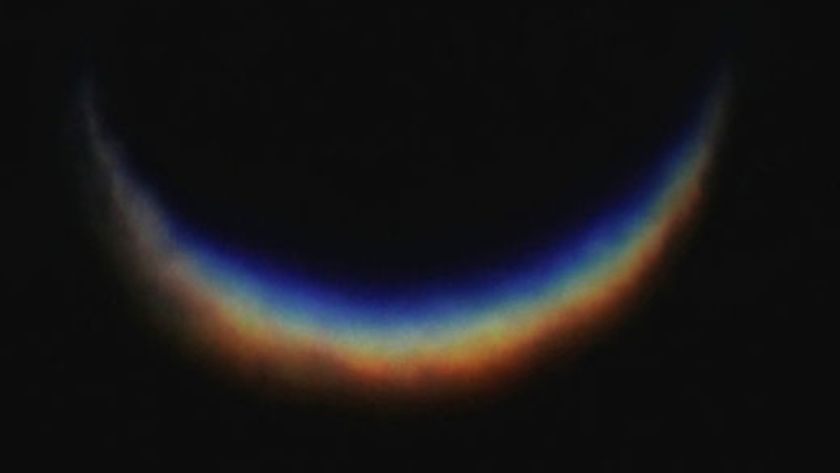Ultrafast Camera Captures 'Sonic Booms' of Light for First Time

Just as aircraft flying at supersonic speeds create cone-shaped sonic booms, pulses of light can leave behind cone-shaped wakes of light. Now, a superfast camera has captured the first-ever video of these events.
The new technology used to make this discovery could one day allow scientists to help watch neurons fire and image live activity in the brain, researchers say. [Spooky! Top 10 Unexplained Phenomena]
Science behind the tech
When an object moves through air, it propels the air in front of it away, creating pressure waves that move at the speed of sound in all directions. If the object is moving at speeds equal to or greater than sound, it outruns those pressure waves. As a result, the pressure waves from these speeding objects pile up on top of each other to create shock waves known as sonic booms, which are akin to claps of thunder.
Sonic booms are confined to conical regions known as "Mach cones" that extend primarily to the rear of supersonic objects. Similar events include the V-shaped bow waves that a boat can generate when traveling faster than the waves it pushes out of its way move across the water.
Previous research suggested that light can generate conical wakes similar to sonic booms. Now, for the first time, scientists have imaged these elusive "photonic Mach cones."
Light travels at a speed of about 186,000 miles per second (300,000 kilometers per second) when moving through vacuum. According to Einstein's theory of relativity, nothing can travel faster than the speed of light in a vacuum. However, light can travel more slowly than its top speed — for instance, light moves through glass at speeds of about 60 percent of its maximum. Indeed, prior experiments have slowed light down more than a million-fold.
The fact that light can travel faster in one material than in another helped scientists to generate photonic Mach cones. First,study lead author Jinyang Liang, an optical engineer at Washington University in St. Louis, and his colleagues designed a narrow tunnel filled with dry ice fog. This tunnel was sandwiched between plates made of a mixture of silicone rubber and aluminum oxide powder.
Sign up for the Live Science daily newsletter now
Get the world’s most fascinating discoveries delivered straight to your inbox.
Then, the researchers fired pulses of green laser light — each lasting only 7 picoseconds (trillionths of a second) — down the tunnel. These pulses could scatter off the specks of dry ice within the tunnel, generating light waves that could enter the surrounding plates.
The green light that the scientists used traveled faster inside the tunnel than it did in the plates. As such, as a laser pulse moved down the tunnel, it left a cone of slower-moving overlapping light waves behind it within the plates.

Streak camera
To capture video of these elusive light-scattering events, the researchers developed a "streak camera" that could capture images at speeds of 100 billion frames per second in a single exposure. This new camera captured three different views of the phenomenon: one that acquired a direct image of the scene, and two that recorded temporal information of the events so that the scientists could reconstruct what happened frame by frame. Essentially, they "put different bar codes on each individual image, so that even if during the data acquisition they are all mixed together, we can sort them out," Liang said in an interview.
There are other imaging systems that can capture ultrafast events, but these systems usually need to record hundreds or thousands of exposures of such phenomena before they can see them. In contrast, the new system can record ultrafast events with just a single exposure. This lends itself to recording complex, unpredictable events that may not repeat themselves in precisely the same manner each time they happen, as was the case with the photonic Mach cones that Liang and his colleagues recorded. In that case, the tiny specks that scattered light moved around randomly.
The researchers said their new technique could prove useful in recording ultrafast events in complex biomedical contexts such as living tissues or flowing blood. "Our camera is fast enough to watch neurons fire and image live traffic in the brain," Liang told Live Science. "We hope we can use our system to study neural networks to understand how the brain works."
The scientists detailed their findings online Jan. 20 in the journal Science Advances.
Original article on Live Science.












